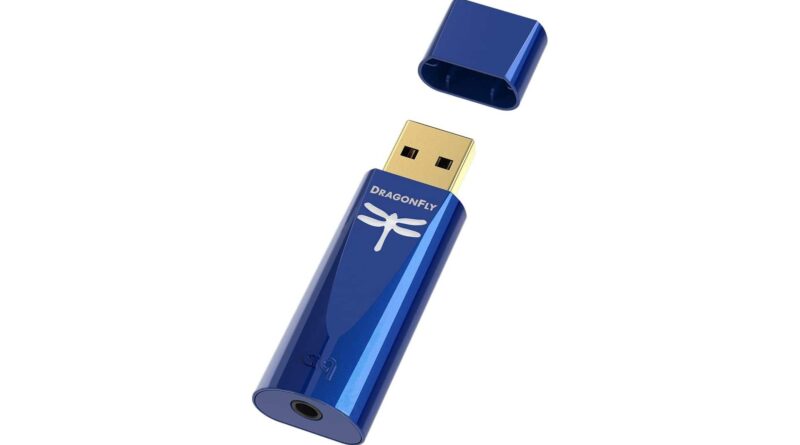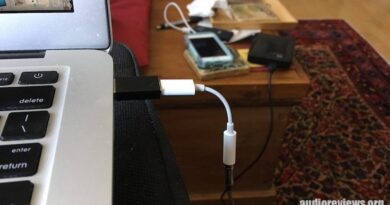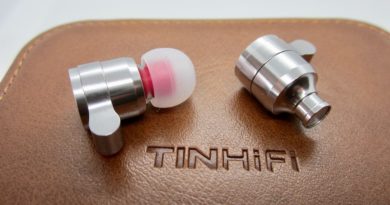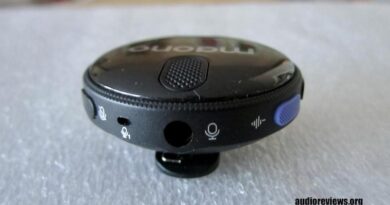AudioQuest DragonFly Cobalt Review (2) – Knowledge Is Power
For those few who might have not heard about it yet, Cobalt is the top-specced variation on AudioQuest’s DragonFly lineup of dongle-format DAC-AMPs.
We already have had a complete review piece about DragonFly Cobalt for almost three years now at audioreviews.org, and based on shared appreciation within our team we decided to stick it onto our Wall of Excellence. As AudioQuest sent me a sample too, I am now sharing my own take on the device.
Very interestingly, AudioQuest recently repositioned Cobalt’s price to € 199,95 in EU (down from € 299,95) – and I can anticipate this is a KO move vs much of its direct competition. Cobalt is widely distributed, and can be purchased from multiple channels including Amazon and many other online platforms.
In this Article
At-a-glance Card
| PROs | CONs |
| Spot-on tonality and timbre | May still sound “too technical” to some |
| Clean, detailed, layered, near-uncolored presentation | Limited output power |
| Commendable bilateral extension | Limited digital resolution support |
| Minimal host power demands | Locked FIR filter choice |
| Full iPhone/iPad host support | |
| MQA Rendering |
I am not writing these articles to help manufacturers promote their products, even less I’m expecting or even accepting compensation when I do. I’m writing exclusively to share my fun – and sometimes my disappointment – about gear that I happen to buy, borrow or somehow receive for audition.
Another crucial fact to note is that I have very sided and circumscribed musical tastes: I almost exclusively listen to jazz, and even more particularly to the strains of post bop, modal, hard bop and avantgarde which developed from the late ’50ies to the late ’70ies. In audio-related terms this implies that I mostly listen to musical situations featuring small or even very small groups playing acoustic instruments, on not big stages.
One of the first direct consequences of the above is that you should not expect me to provide broad information about how a certain product fares with many different musical genres. Oppositely, you should always keep in mind that – different gear treating digital and analog sound in different ways – my evaluations may not, in full or in part, be applicable to your preferred musical genre.
Another consequence is that I build my digital library by painstakingly cherry-pick editions offering the least possible compression and pumped loudness, and the most extended dynamic range. This alone, by the way, makes common music streaming services pretty much useless for me, as they offer almost exclusively the polar opposite. And, again by the way, quite a few of the editions in my library are monoaural.
Additionally: my library includes a significant number of unedited, very high sample rate re-digitisations of vinyl or open-reel tape editions, either dating back to the original day or more recently reissued under specialised labels e.g. Blue Note Tone Poet, Music Matters, Esoteric Jp, Analogue Productions, Impulse! Originals, and such. Oppositely, I could ever find an extremely small number of audible (for my preferences) SACD editions.
My source gear is correspondingly selected to grant very extended bandwidth, high reconstruction proweness, uncolored amping.
And finally, my preferred drivers (ear or headphones) are first and foremost supposed to feature solid note-body timbre, and an as magically centered compromise between fine detail, articulated texturing and microdynamics as their designers can possibly achieve.
In terms of presentation, for IEMs I prefer one in the shape of a DF curve, with some very moderate extra push up in the midbass. Extra sub-bass enhancement is totally optional, and solely welcome if seriously well controlled. Last octave treble is also welcome from whomever is really able to turn that into further spatial drawing upgrade, all others please abstain.
Features and description
Externals
DragonFly Cobalt is the size of an old-school “USB pen drive”, with is encasing painted of a nice blue – or well, cobalt – color.
There are no controls, wheels or buttons whatsoever on the structure. Only after plugging it into a host PC (or Mac, or mobile device) one realises that the stylised dragonfly logo on the top side is indeed backlit by a colored LED, which color changes depending on the input stream digital sample rate:
| Red | Idle (no input) |
| Blue | 48 KHz |
| Green | 44.1 KHz |
| Yellow | 88.2 KHz |
| Light Blue | 96 KHz |
| Violet | MQA |
Internals
The DragonFly product range is based on technology developed by a mr Gordon Rankin, a gentleman busy with seriously innovative digital and analog audio technology and products for the past almost 4 decades.
Gordon’s own company Wavelength Audio Ltd still holds the rights to the registered trademarks and of course the intellectual property at the very heart of AudioQuest’s DragonFl(ies), including DragonFly Cobalt of course.
Just for the sake of historical curiosity – and give Caesar his own, of course – StreamLength® is the given name of Gordon’s original setup which for the first time allowed for a plug-in device to take control of USB communication timing, which was normally exclusively managed by the host (the PC) until then. Such flip of perspective is the crux to the nowadays ubiquitous “Asynchronous USB mode”, the very base to start from and achieve adequate control over jitter when it comes to digital audio communications.
Once put the plug-in device in a control position over communications timing, the other step Gordon took was that of giving the device itself a high precision clock generator, which in DragonFly Cobalt case happens by taking it out of the very ESS ES9038Q2M chip at its core. Such setup was originally named “monoClock® technology” by Gordon.
Another fundamental architectural choice taken inside DragonFly Cobalt is to adopt separate chips for digital reconstruction (DAC) and amplification – as opposed to most of the direct competition relying on “all-in-one” chips doing both things on the same piece of silicon and – which is most significant to our discussion – without offering integrators and users any significant flexibility to change, fine tune, let alone customise the overall system behaviour. That’s why DragonFly Cobalt’s voicing, dynamic range and SNR won’t be apriori similar to that of other dongle devices relying on ES9038-line chips’ internal amping features.
Exploiting another feature on ES9038Q2M, DragonFly Cobalt comes with a custom designed minimum-phase slow roll-off FIR filter.
While I have no complaints about such choice, considering the hardware offers support for it I would welcome the chance to apply different filters, via good ol’ firmware flashing or even better via some sort of mobile app. Maybe there’s a chance this would come in the future?
USB communications are carried out via the good deeds of a Microchip’s PIC32MX274 IC, featuring extremely low power needs, also vis-a-vis its programming for support only USB-1on DragonFly Cobalt.
All such choices – the DAC chip, the AMP chip, and the USB processor chip – contribute to DragonFly Cobalt being amongst the lowest-power-demanding dongles on the market when it comes to host supply needs, which is why it is one of the very few to offer full compatibility with iPhone/iPad hosts, notoriously unable to deliver other than very low power off of their Lightning sockets.
Mind you though: free meals not being a part of real life, nor any divinity existing taking care of creating energy from nothing no matter how hard you pray, low input power draw means a few things that you do need to keep in mind to set the correct expectations about DragonFly Cobalt’s performance.
One: the USB-1 protocol drains much less power at the cost of a limited maximum transfer speed, which in terms of digital audio values turns into a 24 bit / 96 KHz digital resolution cap. And… PCM only! No DSD support.
Two: the ESS 9601 amp will prove limited in terms of maximum output power, with particular regards to current . So while it will reliably deliver a nice 2.1 V max swing on high impedance loads, DragonFly Cobalt will not (as it can not) adequately power low(er) sensitivity drivers, especially if featuring low impedances too.
So in practical terms you should not rely on DragonFly Cobalt to properly driver the likes of final E5000, or final B1, or final A3000, let alone pretty much any planar driver.
And, no surprise should arise when Cobalt will seem to “struggle” (e.g. in terms of loss of treble control) with “mid-hard” loads. All that will be due to the device’s internal power circuitry “running out of current” in some situations, having it apriori been set up not to request more than a certain, very limited power from the host device to begin with.
Input
Like all pure “dongles”, DragonFly Cobalt only accepts USB input.
Very “classically” the device carries a USB-A male plug, so in itself it’s ready to plug onto any common PC or Mac USB port.
A USB-A to USB-C short cable adapter is supplied too, to facilitate connectivity with more recent smartphones. More on the adapter under Package, here below.
Output
DragonFly Cobalt’s sole output is its analog 3.5mm connector, of course accepting any 3.5mm single-ended terminated load.
Those who (also) own balanced-ended sources will most likely have a few or many of their drivers equipped with balanced terminated cables, and will need a balanced-to-single-ended adapter to plug them onto the Cobalt.
Host power requirements
DragonFly Cobalt requires very low power from the host (i.e., the PC, the phone or the dap it is connected to and therefor powered from). I’m talking about just 60mA when idle (i.e. when connected but “doing nothing”), and between 150 and 200mA when playing out on good volume on a mid-impedance driver.
This is of course very good news, but grounds for some caveats too.
Starting on the good side: DragonFly Cobalt will not suck your phone battery dry in no time like so many direct competitors and (!) it will perfectly work with iPhones and iPads, known picky fellas when it comes to the powering requirements of the devices you plug onto them. It will also not more than vaguely warm during operation.
On the flip side there are two important notes to make – which I indeed already mentioned above under “Internals”.
One: DragonFly Cobalt exclusively supports the USB 1 protocol speeds (USB 2 would require more power), which translates into a maximum supported input resolution 24 bit, 96Khz PCM (and no DSD).
Two: DragonFly Cobalt’s maximum output power will be, of course, limited, too: expect it to be good for powering high impedance (300 ohm) dynamic drivers (e.g. Sennheiser HD-series cans) and mid-impedance (20-30 ohm) not particularly demanding IEMs – which are, combined, probably >95% of the drivers out there anyway.
Volume and gain control
DragonFly Cobalt offers no physical control options so there’s no way to set the gain, and the sole way to manage its volume is via the host’s digital volume control.
On such latter front a point, as you may or may not know, the Android operating system divides the USB device volume range in only 40 steps (or even 25 for the latest Android releases…). When operating a device like DragonFly Cobalt this results in the last ticks of the volume control range converting into way too big SPL variations.
So if you are planning on using DragonFly Cobalt on a Android-based host just keep in mind that the way to “fix” this is using a better featured music player app e.g. UAPP or others – which is what you would normally do anyway for a number of other reasons one above all bypassing standard Android audio drivers – re-defining the number of steps Volume control is divided into (up to 250, on UAPP).
Other features
MQA Rendering
I won’t spend a word on what MQA itself is, of course. Google around if you wish and you’ll be overflooded with info.
What matters here is: DragonFly Cobalt is a “MQA Renderer”, so it can fully unfold MQA tracks on its own hardware, which is an upgrade vs the default represented by having the music player host do the unfolding, and only limited to the first 2 folds.
Singers/players/bands/publishers record their tracks, and eventually release their albums. Prior to the digital music distribution era, there could be very little doubt about whether the music we were listening to was the “original” version of that album as its creator/publisher intended or not; if we had a legit copy of that LP or of that CD, that was it.
In the digital music distribution system, instead, the end user has no “solid” way to make absolutely sure that he’s receiving an unaltered version of those tracks. For what he knows, he might be getting a subsequently remastered, equalised, anyhow manipulated version of that album.
The MQA offers a way to “certify” this. An “MQA Studio” track is a file which containes some sort of “certification codes” that guarantee that track is indeed “the original” as released by the authors. A sort of digital signature, if you wish. Anyone might process, EQ, remaster, etc, that track, and re-encode it under MQA but the new file wouldn’t carry the original author signature anymore.
“MQA Original Sample Rate” (a.k.a. “MQB”) tracks are MQA Studio Tracks for which a further certification is given that not even the mere sample rate has been altered (in particular: oversampled) compared to the “original version” as released by the authors.
Any MQA-capable device (called MQA Renderer) can play back all MQA encoded tracks, but only MQA Full Decoders are able to identify such additional “digital signatures” and tell the user “hey, this is an original track” or not.
Ifi GO Bar, Gryphon, HipDac-2 are all examples of Full Decoder devices. AudioQuest DragonFly Cobalt, Ifi GO Link, HipDac, Micro iDSD Signature, Nano iDSD Black Label are all Renderers. Ifi Go Blu, Apogee Groove are finally examples of non-MQA-capable devices.
That said, I don’t personally care about MQA, nor about any of the existing digital distribution catalogues for that matter, due to the fundamental lack of good editions of the music I prefer on there.
Firmware
For their DragonFly product line AudioQuest offers free software for users to autonomously carry on firmware upgrade operations when needed.
For DragonFly Cobalt no updated firmware version was (yet) ever released, however.
DragonTail
DragonFly Cobalt ships together with two complementary accessories: a leather sleeve, and a USB-A to USB-C short adapter cable – which, as always in AudioQuest’s standards, got its own given name: “DragonTail Extender”.
The DragonTail appear as nothing else than a digital plug format adapter, much needed of course to facilitate connecting the Cobalt to mobile devices like smartphones, or dap/transports. The version bundled with Cobalt is called DragonTail-C as it features a USB-C male plug at its end. AudioQuest also carries a DragonTail-Micro alternative.
What’s probably most interesting about DragonTail is its quality. I won’t take a digital audio cabling detour here, but I think it’s worth to share a very simple experience I had with Cobalt. When I first put it to work I connected Cobalt to my PC, where there’s only a USB-C port available, so I used a “nameless” USB-A to USB-C adapter cable I had laying around on my desk. No surprises: it just worked as I was expecting it to, and Cobalt sounded “right” off the bat.
One day for whatever reason I needed a USB-A to USB-C adapter for another application. Where do I have one? Meh… who knows. While watching around I noticed the one hooked to the Cobalt so I just took that one off, leaving the Cobalt disconnected for a while.
A few days later I wanted to use the Cobalt again, and did not want to “undo” the other cabling involving the other adapter. Time to think harder and try to devine where could I have another one – and that’s when I remembered there must have been one left inside the Cobalt box. Took it. Plugged it. It worked (of course). But… Cobalt seemed to be sounding different.
Mmmh – I thought – that’s very likely my wrong memory. So I carried on, for a day or two. Then, I decided to check it. Undid the other cable chain, recuped the “nameless” adapter cable, and organised a quick A/B test. And yes, there is a difference. When using DragonTail to connect it to my PC the Cobalt delivers fuller notes, and a darker background.
As I mentioned en-passant within my article regarding AudioQuest’s JitterBug, a passive cable cannot possibly “improve” a digital signal. However, it can deplete it. So what is actually happening on my case is that DragonTail revealed that the other cable was introducing noise… 🙂
DragonFly Cobalt sound
DragonFly Cobalt sounds detailed, dynamic and most of all clean, yet significantly musical.
In terms of cleanness in particular it trades (hard!) blows with the E1DA’s 9038SG3 and 9038D, arguably the “cleanest” – in the sense of most distortion-free – dongle-class devices one can find.
Which leads me right to articulate about the true crucial point of Cobalt’s sound: its stunningly spot-on compromise between resolving power, transparency and musicality.
I can name other more musical (“gracefully colored”) dongles. I can name more transparent ones, too. Very often, if not invariably, auditioning one of either group makes you soon want one from the other. Cobalt is not that. When listening to Cobalt’s clean notes you can’t fail noticing how expressive they also are, and, while going with Cobalt’s musical flow you’ll never feel you are really missing tiny beats, or soft nuances.
Cobalt’s output is masterfully “balanced”, not in the meaning we most commonly give to the word, regarding properly reciprocally calibrating lows mids and highs, rather is the sense of delivering as much of both – transparency and musicality, clean timbre and personal tonality – one can realistically hope to have at the same time.
Considerations & conclusions
DragonFly Cobalt is an absolutely remarkable piece of gear offering high quality reconstruction, reference-level amping transparency and delicious tonality, all near-magically mixed together at a unique mixture spot.
With its minuscule input power demands Cobalt is possibly the easiest in its class to pair with any mobile transport, iPhones and their (in)famous interfacing standards and power-out limitations. And, its single-ended output fully supports all those stock wires you may have a drawer full of, without leaving a balanced alternative to be desired.
Some may consider its modest maximum output power a limitation, and technically right so. However, in practical terms they translate into letting out possibly less than 5% of the IEMs on our Wall of Excellence.
DragonFly Cobalt was stuck onto our Wall of Excellence long ago, when its price was € 299,95. Now it’s been repositioned to € 199,95. Enough said, I guess.
The Editor: I have been using the Cobalt daily for the last three years...despite a drawer full of dongles: sounds great, has low power consumption, is small and light, and easy to use. The (monetary) value is mainly in its DAC part.
Our generic standard disclaimer.







